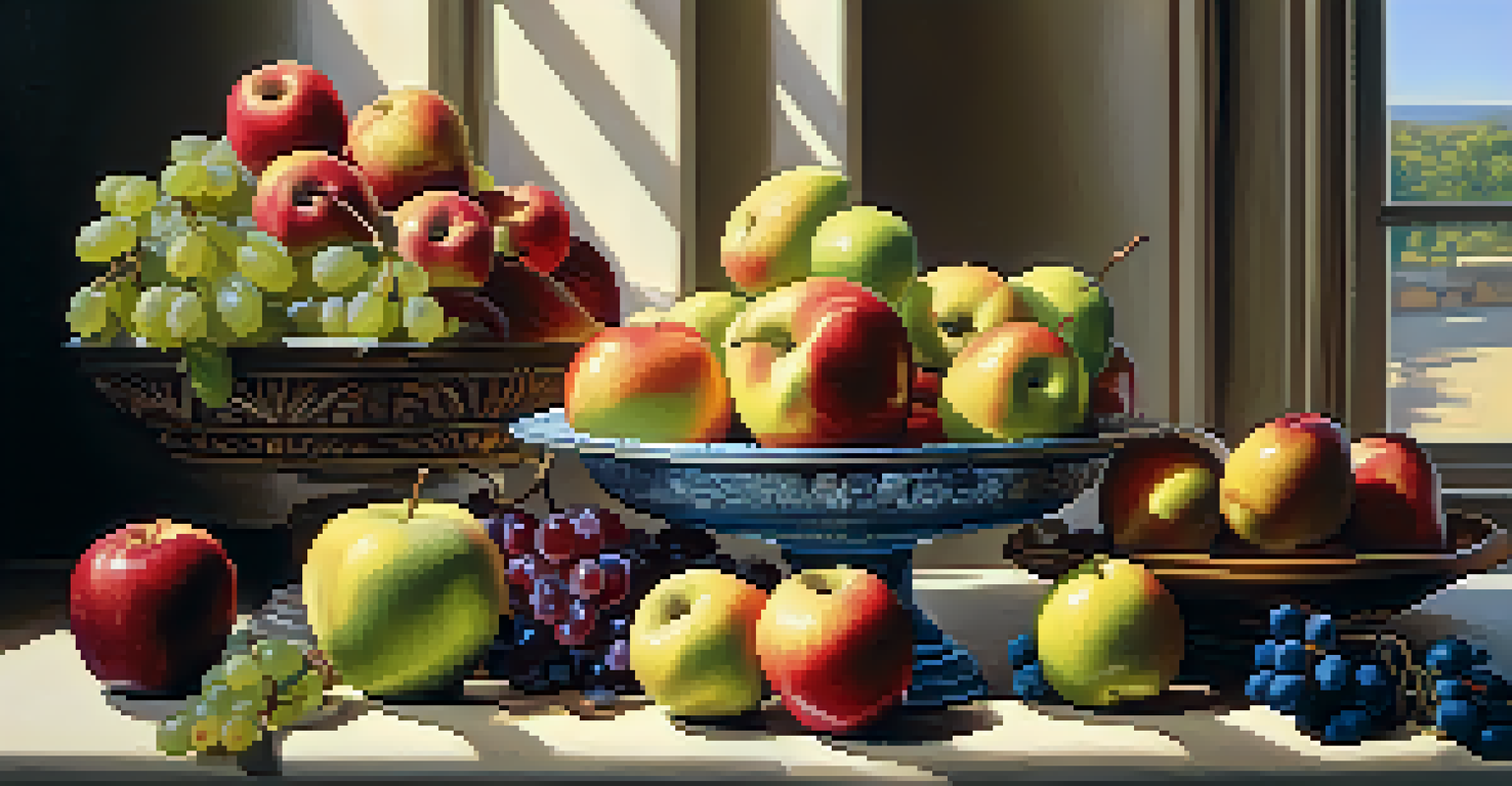Historical Perspectives on Critique in the World of Painting

The Origins of Art Critique in Ancient Civilizations
Art critique has roots that stretch back to ancient civilizations, where artworks were often judged based on their adherence to cultural and religious standards. In societies like ancient Greece, philosophers like Plato and Aristotle began to articulate their thoughts on art, laying the groundwork for future critiques. They discussed concepts such as beauty and the purpose of art, influencing how artworks were perceived and evaluated. Consequently, these early critiques set a precedent for later discussions about artistic merit and meaning.
Art is the most beautiful of all lies.
As time progressed, the focus of critique began to shift from mere technical skills to a deeper exploration of themes and emotions in art. This transition marked a critical evolution in how artists were evaluated, as critics began to consider the societal context and personal expression behind the works. For instance, during the Renaissance, critiques often emphasized the use of perspective and anatomical accuracy, reflecting the period's values in art appreciation.
Thus, the origins of art critique laid a foundation that established not only the importance of evaluation but also a framework for discussing art's broader significance. This historical perspective highlights that art critique is not just about aesthetics but also about cultural commentary and philosophical inquiry.
The Role of Artists and Critics in the Renaissance
The Renaissance was a pivotal moment for both artists and critics, as it saw a blossoming of creativity that demanded new forms of critique. Artists like Leonardo da Vinci and Michelangelo not only produced masterpieces but also engaged with critics in meaningful dialogues about their work. This interaction was essential as critics began to appreciate the individual artist's intent and the innovative techniques employed in their creations. Critics, in turn, helped shape public perception, elevating artists' status in society.

During this time, art criticism began to formalize, with the emergence of dedicated publications and academies. Critics would analyze works in terms of composition, color, and emotional impact, providing a structured approach to evaluation. For example, the Venetian painter Titian's use of color was frequently discussed, influencing both his contemporaries and future generations of artists.
Art Critique's Historical Roots
Art critique has evolved from ancient philosophical discussions to a complex dialogue that encompasses cultural, emotional, and societal contexts.
The Renaissance illustrates how the relationship between artists and critics can significantly impact the development of art. This period's critiques were not merely assessments; they were vital conversations that shaped artistic movements and encouraged innovation.
The Enlightenment: Expanding the Scope of Critique
As the Enlightenment emerged, the critique of art expanded beyond aesthetic considerations to include intellectual and philosophical dimensions. Critics began to analyze art in relation to reason, morality, and societal values, reflecting the era's emphasis on rational thought. This shift allowed for a broader interpretation of art, where critics evaluated how artworks resonated with contemporary ideas and issues, such as liberty and democracy.
Every artist dips his brush in his own soul, and paints his own nature into his pictures.
For instance, critics like Denis Diderot used the Salon exhibitions in France to critique art publicly, sparking discussions that influenced both artists and the public. Diderot's writings often examined the moral implications of art, questioning the responsibilities of artists to society. This approach encouraged artists to think critically about their subjects and the messages they conveyed through their work.
The Enlightenment period thus marked a significant evolution in art critique, paving the way for future movements that would further intertwine art with philosophical and social commentary. It underscored the importance of context in understanding and appreciating art.
Romanticism: Emotion and Individual Expression
The Romantic movement brought a dramatic shift in art critique, emphasizing emotion and individual expression over rigid constraints. Critics began to champion artists who expressed their feelings and experiences, fostering a sense of personal connection between the artwork and the viewer. This period saw a rise in the importance of subjective interpretation, where critics like John Ruskin argued that the emotional impact of art was as crucial as technical skill.
Artists such as Caspar David Friedrich and J.M.W. Turner became icons of Romanticism, celebrated for their ability to evoke emotion through their landscapes and use of light. Critics praised their works for their capacity to convey feelings of awe and introspection, encouraging a more personal engagement with art. This new focus on emotion changed the landscape of critique, making it more inclusive of diverse artistic expressions.
The Impact of Movements on Critique
Each artistic movement, from the Renaissance to Modernism, reshaped art critique, influencing how critics assess and appreciate new styles and techniques.
Romanticism ultimately shifted the narrative of art critique from a purely technical evaluation to a celebration of the artist's emotional journey. This evolution allowed for a richer dialogue about art that remains relevant today.
Impressionism: Challenging Traditional Norms
The advent of Impressionism in the late 19th century marked another significant turning point in the history of art critique. Impressionist artists like Claude Monet and Edgar Degas challenged traditional artistic norms, favoring spontaneity and the effects of light over precise detail. Critics struggled to understand and appreciate this new style, as it departed from the established conventions of realism.
Initially met with resistance, Impressionism eventually garnered its own group of supporters who praised its innovative approach. Critics began to recognize the emotional responses evoked by the loose brushwork and vibrant colors, shifting their perspective on what constituted 'good' art. This transition illustrates the dynamic nature of art critique, where new movements can initially be met with skepticism before gaining acceptance.
Impressionism's legacy in art critique lies in its encouragement of experimentation and the breaking of norms. It opened the door for future movements, demonstrating that critique can evolve alongside artistic innovation.
Modernism: Redefining Artistic Boundaries
The rise of Modernism in the early 20th century redefined the parameters of art and its critique. Artists like Pablo Picasso and Wassily Kandinsky broke away from traditional representations, embracing abstraction and challenging the notion of what art could be. Critics had to adapt to this new landscape, often grappling with the complexities of interpreting abstract works that didn't adhere to recognizable forms.
Modernist critics began to explore concepts such as the artist's intent and the viewer's experience, emphasizing the interaction between the two. This era saw the emergence of various critical theories, such as formalism, which focused on the visual elements of art rather than its context or meaning. Critics like Clement Greenberg played a pivotal role in shaping Modernist discourse, advocating for the appreciation of art as an autonomous entity.
Embracing Diversity in Critique
Contemporary art critique champions diverse voices and perspectives, reflecting an inclusive approach that recognizes the significance of race, gender, and identity in artistic expression.
The Modernist movement exemplifies how critique can evolve and respond to radical changes in artistic expression. It highlights the importance of adaptability in art critique, ensuring that it remains relevant in the face of innovation.
Contemporary Critique: Embracing Diversity and Inclusion
Today, art critique reflects a diverse and inclusive spectrum of voices, accommodating a wide range of styles, perspectives, and cultural backgrounds. Contemporary critics are increasingly aware of the importance of representation, examining how race, gender, and identity shape artistic expression. This shift has led to a richer dialogue about the role of art in society and how it can challenge or reinforce cultural narratives.
Critics now celebrate artists from marginalized communities, recognizing the significance of their contributions to the broader art world. This inclusivity not only enriches the critique itself but also encourages a more comprehensive understanding of art's impact on social issues. For instance, the works of artists like Kehinde Wiley and Kara Walker are analyzed not just for their aesthetic qualities but also for their commentary on race and history.

Contemporary critique exemplifies the evolution of art interpretation, showcasing a commitment to diversity and a recognition of the multifaceted nature of artistic expression. This ongoing dialogue is essential for fostering a more inclusive art world.